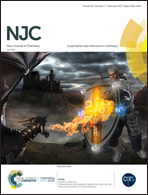Stimuli-responsive nanotheranostics intended for oncological diseases: in vitro evaluation of their target, diagnostic and drug release capabilities†
Abstract
Magnetic nanotheranostics were designed from iron oxide nanoparticles functionalized with folic acid (FA) and loaded with doxorubicin (Doxo) as a therapeutic agent. The incorporation of Doxo was carefully examined to attain a satisfactory drug loading efficiency. The magnet-guiding ability was examined in vitro. To achieve this, a novel continuous flow system was fabricated to quantify the amount of MNPs retained in the magnet site in an environment and under conditions mimicking the bloodstream. The obtained data suggest that almost 21% of the total circulating nanoparticles accumulated in the target site after 45 min of assay. Such amount ensured the doses of Doxo commonly employed during in vivo studies. The release of Doxo was analysed by implementing an original procedure devoted to simulate the pathways followed by MNPs once intravenously administered. From these studies, reliable data on the amount of drug that effectively reached the target site were obtained. The efficiency of the nanosystems as selective contrast agents in MRI was analysed using clinical 1.5 T equipment. Their potential as T2 weighted contrast media was demonstrated. The data collected within this work appear as the former initial stage to validate the nanotheranostics before in vivo evaluation of this novel technology.



 Please wait while we load your content...
Please wait while we load your content...